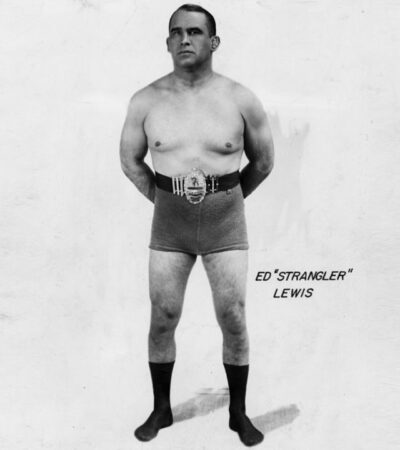Eustace Wrestles The Champ
Nyob rau lub Xya hli ntuj 4, 1922, Alan Eustace tau txais nws txhaj tshuaj ntawm lub ntiaj teb Heavyweight Wrestling Champion Ed “Strangler” Lewis. Eustace, Tus Kansas Champion, yeej a qualifying match with “Ua teb” Bailey nyob rau hauv lub peb hlis ntuj 1922 Tsim nyog rau ntais ntawv nrog Lewis.
31-Xyoo Eustace yog tib hnub nyoog li “Strangler” Lewis tab sis Lewis yog nyob deb tshaj tej yaam puab paub. Debuting ntawm 14 xyoo, Lewis had almost 10 more years of experience than Eustace.
Eustace was born and lived in Wakefield, Kansas. Being a local product was a big plus for Wichita promoter Tom Law, who promoted Eustace as his top wrestler and champion. Due to Eustace’s local reputation, Law was expecting a big crowd for his Independence Day card in Wichita, one of Kansas’ biggest towns.

Photo of Alan Eustace in 1922 (Public sau)
Hmoov tsis, none of the newspaper coverage reported attendance figures. The newspapers did say most of Wakefield, Kansas’ population was present among a good crowd. Wichita was also a regular town for the Gold Dust Trio, so it is reasonable to think they were drawing thousands of fans regularly.
The fans were treated to an exciting match between Eustace and the reigning champion. How Lewis wrestled Eustace also showed Lewis’ respect for Law and Eustace. Lewis let Eustace take the first fall.
The men wrestled a fast-paced match full of counters for the first 38 minutes of the match. Lewis primarily defended against Eustace’s offense during the first fall. Eustace would use his strength to put Lewis in danger but Lewis would reverse out prior to being pinned each time. At the 38-minute mark, Eustace caught Lewis in a reverse armbar. This time Lewis was unable to reverse the move and Eustace pinned him for the first fall.

Ed “Strangler” Lewis nrog nws lub npe npe belt (Public sau)
Lewis used the second fall to setup the remainder of the match. Lewis normally locked a headlock onto his opponent and threw them repeatedly with this move. Txawm li cas los, Lewis also had a go-behind move, where Lewis went to a knee, spin around his opponent and secured a body hold from behind. Lewis’ chest would be pressed against his opponent’s back.
Even though Lewis used the move in this worked match, it was a legitimate wrestling movement Lewis would use in shoots (actual contests) and to thwart double-crosses. Lewis used the move on Joe Stecher in a shoot contest to reunify the world titles in 1928.
Hauv no match, Lewis used the move to get behind Eustace and move him into position for a toe hold. Lewis held the toe hold on for several minutes before Eustace submitted at the 12-minute mark. Eustace was limping visibly, when he left the ring for the 10-minute intercession.
Both Law and the Gold Dust Trio wanted to keep Eustace strong. To give a wrestler a credible reason for a loss, the injury angle was a frequent tactic used by the Gold Dust Trio. Fans would often overlook a loss by one of their favorites, if the wrestler continued the match despite an injury. Fans could say, “If it wasn’t for the injury, he could have beaten the champion.” The promoters executed this angle well in this instance.
Tom Law and the ringside doctor tried to convince Eustace not to continue the match but he insisted on finishing the match. Eustace bravely faced the decorated Lewis even though he wasn’t 100 feem pua. Lewis finished off the “injured” wrestler in 30 seconds for the third fall and match. Lewis was still the champion but Eustace came out of the match as a credible title challenger.
Eustace continued his career into his forties primarily wrestling in Kansas. While never reaching World Championship status, Eustace proved a good opponent for champions passing through Kansas. He was also instrumental in helping Tom Law establish the Wichita Territory.
Koj yuav tawm ib saib los nug cov lus nug txog qhov no los yog tej tsev xa rau kuv Facebook phab.
Tau qhov twg los: Wichita Daily Beacon, Lub Xya hli ntuj 5, 1922 ib tsab, p. 4 thiab wrestlingdata.com
PIN rau nws
